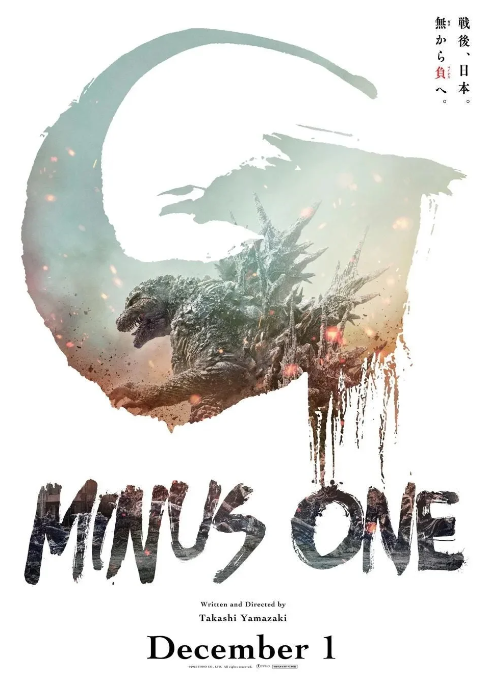*Contains mild spoilers common to reviews
“Godzilla Minus One” (Japanese title: ゴジラマイナスワン or “Gojira -1.0”) is the best Godzilla film to come out since the original 1954 “Gojira.” It’s an emotional ride through post-World War II Japan as that country recovers from devastation, only to be confronted with something even more dangerous and destructive–and uncontrollable. “Godzilla Minus One” is a film about post-war survivor’s guilt and found family that also happens to have a giant kaiju wreaking havoc in the background.
Directed by Takashi Yamazaki from his own script, “Godzilla Minus One” begins on Odo Island, where Koichi Shikishima (Ryunosuke Kamiki, who gives an Academy Awards-caliber performance), a kamikaze pilot, has faked a problem with his plane so he can avoid his death mission. His cowardice makes him anathema to the mechanics on the island even though the war is almost over, with Japan assuredly losing. As they argue with Shikishima, a giant creature the islanders call Godzilla rises from the ocean and attacks. One last act of cowardice allows Shikishima to survive, along with one other person who blames him for all the deaths. It’s a heavy burden that leaves Shikishima a shell of a man.
Shikishima returns to a bombed-out Tokyo after the war. Being a kamikaze pilot who lived renders him a pariah. His neighbor, Sumiko (Sakura Ando), is disgusted to see him. The guilt he carries over the mechanics’ deaths, exemplified in a pile of their family photographs given to him on his journey home, exacerbates his fragile mental state. His parents having perished in the bombings in Tokyo doesn’t help, either.
One day, hubbub at the local marketplace brings Noriko (Minami Hamabe), who was given a baby to care for by a dying woman, into Shikishima’s life. Noriko winds up staying at Shikishima’s; even Sumiko’s hard feelings towards Shikishima soften when she meets the baby.
As the years pass, we see Tokyo slowly rebuilding. Shikishima takes a well-paying but dangerous job clearing out ocean mines, where he meets the captain Yoji Akitsu (Kuranosuke Sasaki), Kenji “Doc” Noda (Hidetaka Yoshioka), and the “Kid” Shirō Mizushima (Yuki Yamada). The four form a brotherly bond. Meanwhile, Shikishima continues to be haunted by nightmares of Godzilla’s attack and the deaths of all the men he met on Odo Island. He closes himself off to love and basically living.
Elsewhere, the United States conducts nuclear tests at Bikini Atoll, angering a now-much larger Godzilla, who begins attacking boats. Japan and other world powers keep Godzilla’s existence a secret from the world, but when the U.S. fears Soviet reprisals if they send warships to the area to assist in destroying Godzilla, Japan is on its own dealing with the kaiju menace. Godzilla is an existential threat to humanity that no one wants to take responsibility for.
A lot of political undercurrents pulse through “Godzilla Minus One.” Apart from U.S. imperialism causing a huge problem then peacing out on dealing with it, there’s also the way the Japanese government has been treating its people. There’s a growing discontent among Tokyo’s denizens who are already dealing with the after-effects of a war they apparently didn’t want to fight in the first place, and now a giant monster is on the way? Will the military come in and save the day, or will the people rise up to fight against the growing threat Godzilla poses? The country is already at “zero” because of the war, and Godzilla’s attacks set it back to negative one (hence the film’s title).
“Godzilla Minus One” has callbacks to the 1954 film, including excellent use of Akira Ifukube’s original “Godzilla” score and breathless narration from a reporter watching an attack unfold, as well as other Easter eggs for Godzilla nerds. But the core of the film is Shikishima’s journey through his guilt and his death wish. Kamiki’s acting as Shikishima anchors the film with its sheer emotional force. Shikishima looks haunted because he is haunted–by his cowardice, by his belief that he doesn’t deserve love or even to live, and by Godzilla, the symbol of his trauma. It’s effective and affecting.
Also, “Godzilla Minus One” just looks spectacular. It was made on a $15 million budget, but it seems like they spent much more. Cinematography, especially the sea scenes, is magnificent, and Godzilla himself is a wonder. He looks a little like 1954 Godzilla, a little like Shin, and even has more chonky thighs like Monsterverse Godzilla, with other Godzilla iterations mixed in. He also appears to be in terrible pain just existing, which is part of the original Godzilla’s backstory (his skin resembled keloid scars suffered by the survivors of Nagasaki and Hiroshima). He’s fearsome and awe-inspiring, and his attacks throughout the film are both exhilarating and utterly terrifying, even more so than the main attack in “Shin Godzilla,” which is my personal high mark of modern Godzilla destruction. That the main attack in the film also echoes the horrifying one in the 1954 version only adds to its power.
“Godzilla Minus One” is an epic film boasting stunning visual effects and deep emotional heft, with its central performances from Kamiki, Hamabe, Sasaki, Yoshioka, and Ando keeping you invested in the human saga while waiting for the monster mayhem. Yamazaki has said that he would like to make another Godzilla film. Here’s hoping Toho Studio agrees because “Godzilla Minus One” is amazing.

